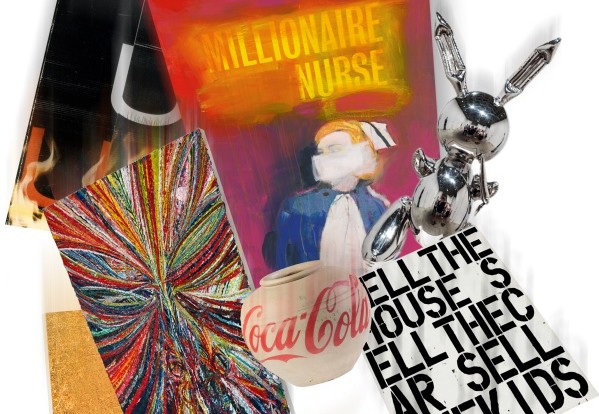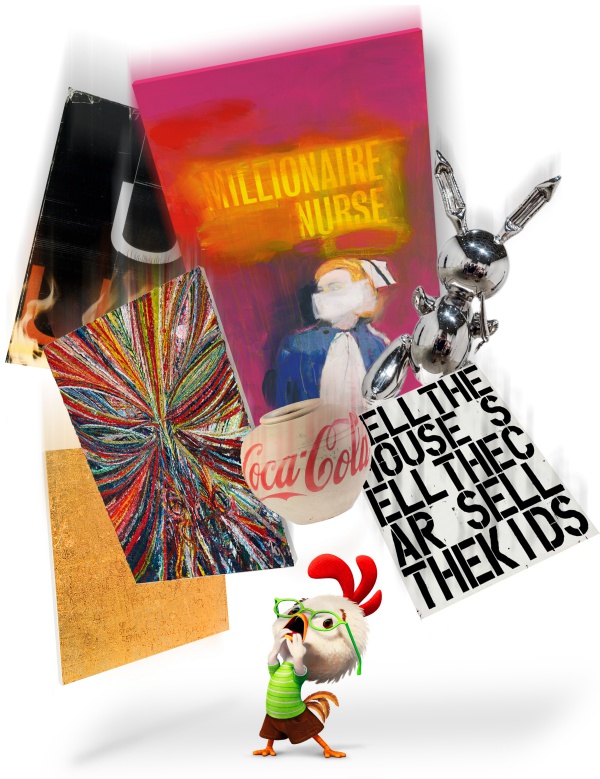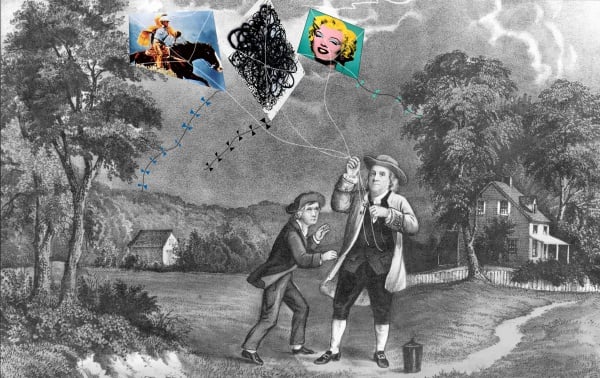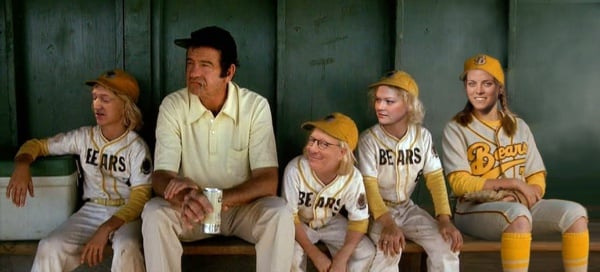Opinion
Kenny Schachter on London’s February Auctions: The Sky Is Falling—Or Is It?
Going behind-the-scenes at the auction houses.

Going behind-the-scenes at the auction houses.

Kenny Schachter


Collage by Kenny Schachter.
Image: Courtesy of Kenny Schachter
The Sky is Falling—Or Is it?
Breaking news: stocks take a historic plunge amid a global rout and oil slumps to a 13-year low. Even more shocking is that the art market squeaked by during the latest spate of mid-term London auctions, markedly less in volume than last year, with some unpleasant surprises including the withdrawal of a mega Richter—but not without a few records and crazy prices. Yes, sales were down in volume up to 50 percent across the board from Impressionism and modern to contemporary yet still fared better than most discretionary bank trading programs and hedge funds.
As a result of the unheralded whipsawing violently shaking confidence in the financial sector, there’s not much other than art to satisfy the primal craving to hunt and gather (for unbridled profit). In the recent past, the art market could be faulted for chewing without tasting at auctions and fairs—the equivalent of buying without looking. Consider the new state of affairs a healthy pause to take stock of what’s at hand.
This is more along the lines of post-sale opinion piece than financial recap—I was never very good at counting. It would be foolhardy to believe, hope or pray that art would be impervious to an historic economic plummet. Having said that, how well art did after the short-lived 2008-10 dip is unassailable. Art always fares better than the pundits report in their shrill hysterics aimed at drawing eyeballs; Christiane Amanpour rarely, if ever, reports on good deeds.
Gloom & Doom
“Everyone look out! The sky is falling!” said the main character in the famed folk tale about a chicken who mistakenly believes in the imminent demise of the world as we know it. But whether you call the story Chicken Little or Henny Penny, its conclusion just ain’t so. But saying so is a well-worn media ploy to talk down a market; it makes for better reading than things moving along at a healthy, albeit sideways, clip. After such a run-up over the past five years in the art market, what’s not normal about consolidation? For the bevy of bad news bears, i.e. reporters for The International New York Times, The Wall Street Journal, New York Magazine, and Bloomberg, I have some news: you were wrong! The art market is alive and kicking and not going anywhere anytime soon.
The presale news read like a conspiracy of left-leaning catty cats. A report on the reporters wouldn’t score very high. I say phooey to all of them, they were merely inciting unreasonable fear and besides, none of them have ever sold a piece of art so how would they know to begin with? By placing nasty thoughts in the minds of their readers, these journos were effectively casting a pall over the market, trying to instill the belief that it was in a state of shit as a fait accompli—the witches of the art world right out of Shakespeare’s Macbeth.

Collage by Kenny Schachter.
Image: Courtesy of Kenny Schachter
Behind the Scenes in the Auction Houses
The behind-the-scenes machinations at the auction houses are more significant than the results, and fit for an HBO drama series. If you’ve been living under a rock and failed to take note, Sotheby’s bought Art Agency, Partners—the art advisory firm launched by Amy Cappellazzo, Allan Schwartzman, and Adam Chinn—for $50 million up front with a $35 million kicker if they meet certain financial expectations. Everyone wants to be an art advisor, really badly. And apparently, that includes the auction houses.
This deal has been more disruptive in more fabulous ways than I can keep track of. Let’s start with Allan Schwartzman: there’s a little known fact that he is a former reporter for the New Yorker and the now defunct mag Seven Days; at a $20 million payout (the deal was $20 million to Amy and Allan, $10 million to Adam), he is among the highest paid art writers in history.
Amy Cappellazzo is an altogether different story. She is a take-no-prisoners practitioner. She made her position abundantly clear when she strode into Sotheby’s executive offices, according to three Sotheby’s staffers I spoke with who were present and who wished to remain nameless, and unequivocally declared, “I am the best boss you’ve ever had.” This episode was reminiscent of the time in 1981, following the assassination attempt on President Ronald Reagan, and Reagan’s subsequent hospitalization, that Secretary of State Alexander Haig asserted before reporters, “I am in control here.” He failed to remember Vice President Bush and the succession protocol under the US Constitution. In this case, however, according to the powers that be (Dan Loeb one assumes), Amy is in control. I heard that she even got her own personal kitchen to the dismay of “lesser” employees.
There were many who begged to differ including the German specialist who is said to have left mid-meeting in a huff, and was later seen engaged in protracted meetings with Christie’s. Then there was the primary auctioneer (I won’t mention names) who I saw at the Connaught Hotel bar in equally engaging talks with Phillips auction house (boy, could they use some help in that department—read on). Seems auction house employees are being traded like football players.
I see this deal more as a ginormous signing bonus to Captain Cappellazzo & Co. to pull rabbits out of their hats in the midst of a hyper competitive auction environment, shorn of guarantees, rather than as a pure financial play to buy a barely-two-year-old company comprised of nothing more than a fistful of personal relationships. I hope it doesn’t signify a market top, though from the looks of Sotheby’s shares, down nearly 20 percent Thursday, alone, it may very well be that. A friend complained to Dan Loeb that Tad Smith, Sotheby’s CEO, is traveling the world via private plane to speak with clients about art. Not to mention he’s better suited to speak sports having hailed from Madison Square Garden rather than the art world.
At Christie’s, Brett Gorvy is up in arms over the fact that his former cohort is now practically an Ultra High Net Worth client herself. This might be considered a reality check for the auction house, which struck a recent swaggering pose after winning market share at the expense of profit margin. Even worse for Christie’s was, according to reports, that their private treaty sales were down well over 50 percent. But what wasn’t mentioned was that incentive commissions were completely withdrawn. Guess what, Mr. Pinault? If they took away your incentive pay, you wouldn’t own Christie’s in the first place.

A collage by Kenny Schachter using the image of a Currier and Ives lithograph of Benjamin Franklin and his son William using a kite and key during a storm to prove that lightning was electricity, June 1752. (Photo by Hulton Archive/Getty Images).
Image: Courtesy of Kenny Schachter
Business as Usual but Worse: The Front Stabbers
I know it sounds implausible and self-serving but I am transparent and forthright and naively expect the same of people I interact with in my private art dealings. But it’s the small lies that rear their head that are the hardest to swallow. The latest version of “the check is in the mail” is that banking “compliance” is holding funds at bay. I’ve even seen more than once bogus swift transfer confirmations, not an encouraging sign. But the only thing worse than being owed money is not owed money.
It’s a nasty domino effect with late payers, more rife in these uncertain times, causing a knock-on effect with clients. I have friends juggling art acquisitions with more kites aloft than Ben Franklin searching for electricity. Nothing prepares you to be stabbed in the face by those you do business (and go on holidays) with but in this small little world you can’t afford to alienate your enemies. And what’s next after an art world provocation amongst friends? Why, dinner of course.
That we are in a more discerning and selective market weeds out a certain stripe of spec-u-lector and is only good. Desperate times call for rash actions: my friend tried to tie up a mediocre work for nearly ten years with a restrictive covenant; but I did the research at my old law firm and these clauses hold about as much water as a leaky faucet.
The Sales
People sell to buy and buy to sell and this trading-up trend is driving the upper reaches of the market, even in an apparent downturn. Welcome to the high end collectible in-and-out club. Be clear, these mid-term auctions never amount to more than dull so I won’t waste much of your time with the details. I am not quite sure the art world has a firm idea of what a flight to quality might look like; there was an erratic and seemingly random list of which works brought in big numbers and which ones didn’t.
I don’t agree with the finance foes, railing against the guarantees, irrevocable bids, enhanced paddles, and presale third party action; they are the market! Buying art is buying art, whether before, during, or after the public act. But let’s have a go at bitching; Phillips might have gone without an audience and conducted a phone-only sale, as there was little or no hand-raising in a room that resembled a still life. With the squirming and stumbling, pick up your game. I don’t care how the profits are increasing. If the dreariness keeps up, then maybe it’s better they turn the shop into a shop: Sell watches and scarves. Why do they want to play against Sotheby’s and Christie’s, why not attack Bonhams, the up-and-coming art player?

Collage by Kenny Schachter featuring journalists Kelly Crow, Jerry Saltz, and Katya Kazakina.
Image: Courtesy of Kenny Schachter
What’s to Come?
The markets were pounded Thursday, Sotheby’s dropped nearly 20 percent, imagine if it tanks again in May; you might be able to buy one share and get two plus a dinner with Dan Loeb and/or Captain Cappellazzo.
Knock on wood. Sorry for the apparent hubris, but I had the best December-through-mid-February, ever. I have seen more deals flow this December and January than I have at any time before, not to mention that I had clients turn down robust offers for works. The buying (and selling) continues unabated; there’s a healthy trade in Rudolf Stingel, Christopher Wool, Mike Kelley, and Gerhard Richter. I’ve even had more than one sad occasion where clients turned down happy offers.
In a nutshell, auction house profits and stock prices have jack all to do with art which will always be coveted, collected, and cherished; like it has done since it came off of cave walls. Guarantees, bubbles, zombie formalists, profits, advisory consultants, private museums, share prices—the lot is nothing but a circus sideshow to the art.
Everyone listen up, auctions are a barometer of the market, not the only one. There is no chart for all the masterpieces that are stored or, in the rare instances, hung. Art’s doing fine thank you very much. Wait till May and see how right I was. Writing on the art market is, in essence, futile; the art lasts, but the vicissitudes of value don’t. Sought-after, it will always be.
Here’s another bit of random breaking news that you read here first: Julia Peyton-Jones has taken a position as a sous chef at the inimitable River Café, run by Ruthie Rogers. Who knows what could be next. In the case of the highflying Julia, if it illustrates anything, it’s that you should keep your options open.
As Shakespeare might have put it had he ventured into art advising (of course, I’m no Shakespeare), which he very well would have, I’ll leave you with a few words inspired by this past week’s auction hoopla:
Song of the Art Witches
Double, double toil and trouble;
Art gets burnt in auction bubble.
Fillet a Tico, and Aby, maybe
But Helly and Larry? No way, baby
Into the caldron boil and bake;
Katya and Reyburn drag their market rake
Saltz’s salt in the eye of a newt
As the Crow crows with the Journal’s boot
Bloomberg and The New York Times
Because they don’t do it, missed the signs
For a charm of powerful trouble,
There you had the flipper’s bubble
You can never discount passion for culture
Damned it be to the naysaying vultures
There’s the wicked drama of mama Kusama
Who cast her nets as wide as Obama
The abject animals of troubled Mike Kelley
Blaze a hole of sadness deep in your belly
Bulls still run for Wools, mingle with Stingels
Tingle with joy every record that’s jingled
Richter, Lawler, Nauman and Gober
Kruger, Sherman…it will never be over.
Double, double toil and trouble;
Art survives alleged bubble.
Before it’s revealed, it won’t be long
Collectively they sang the very wrong song
Since it came off the walls of caves
Art and the market will see another day.